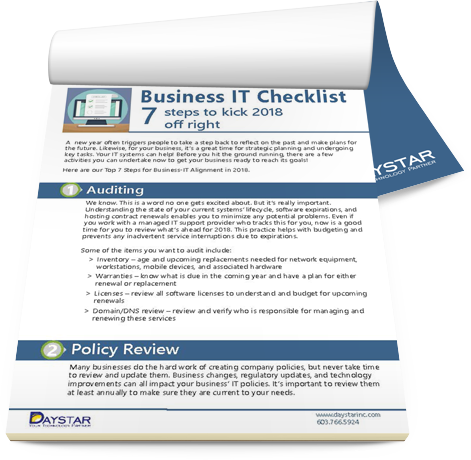 Maybe you have worked with the same IT provider for some time. Perhaps, you handle IT yourself or task one of your employees with the responsibility for every technology solution. If you’re unsure whether your current support is right for your business, it’s important to take a closer look. Your business needs change over time; your business solutions, specifically your IT support, must keep pace.
Maybe you have worked with the same IT provider for some time. Perhaps, you handle IT yourself or task one of your employees with the responsibility for every technology solution. If you’re unsure whether your current support is right for your business, it’s important to take a closer look. Your business needs change over time; your business solutions, specifically your IT support, must keep pace.
Changing providers may seem like a major headache that requires more time than you have to give. However, staying put is like standing still… and is that really what’s best for the business? Although it’s intimidating, the benefits will make it worthwhile. What’s more, even the process of change can uncover new opportunities for your business and, when done properly, may not be as difficult as you think it will be.
Often, there is no one reason a business decides it’s time to change IT providers, but rather a variety of contributing factors. It’s not always clear if the time is right. However, there are some general indicators that may help.
Size
Size is one of the easiest triggers to identify. No matter if you are a small business or significantly larger, when your business grows, your IT support needs can change. When this happens, you often begin to feel that your team has outgrown your current IT services . This normally manifests in one of three ways: numbers, dependency, or sophistication.
Adding employees or locations increases the number of devices and amount of equipment that must be supported and managed. For many small businesses, a single internal IT resource or a small break/fix provider no longer will do. The difference in supporting 5 versus 15 employees is vast. No longer is it as cost-effective to spend your team members' time trying to find an on-site solution. When your numbers grow to the point that your current provider can’t keep up, it is time to consider outsourcing and upgrading to a more proactive managed IT services model.
When your size increases, your dependency on technology also grows. Consistent, reliable support is required. A single IT person who has other clients, takes periodic vacations, or even gets sick once in a while cannot provide the availability you need. Whether it’s a help desk or a small support team, you now require multiple resources to ensure access to support when you need it.
As you grow, your technology needs often get more sophisticated. File sharing, email configurations, access rights, connectivity, and security become more complex. If your current IT provider does not have the knowledge and resources to expertly guide your business, it is time to find support that can.
Frustration with your IT support
Whereas size is the easiest trigger to identify, frustration is the most common one. If you, or your team, are regularly dissatisfied with your IT support, consider it a big red flag. Frustration usually stems from two main areas: support and account management.
Common tech support issues include:
- Unresponsive help desk support
- Recurring problems
- Finger pointing or blaming
- Careless data security processes
- A lack of listening or desire to understand your IT challenges
Frustrations with account management usually center around sales and billing. Excessive up-selling, unexpected charges, and a lack of transparency are some of the issues we hear about most often.
It’s important to understand that this frustration is more than simply aggravating; it also negatively impacts your business’ productivity and bottom line. Spending some of your downtime dealing with an IT issue every once in awhile might be ok, but over time the soft costs of lost productivity can be staggering. This is one area you want to address quickly to provide you peace of mind.
Over time, businesses will undertake new initiatives that fall under a combination, if not all, of these four main drivers. What’s important is to focus on outcomes that drive growth for your business. By properly aligning your business goals with your IT services, you can prioritize the outcomes that will provide the most impact.
Although it may seem like the hot new buzzword, digital transformation is not a new concept. What once was only a priority for larger companies is just not the case anymore. No matter if you run an organization of thousands or are a small business owner, your business requires you to stay informed and up to date in this digital age. Many businesses are already doing it, without even realizing it’s a “thing”. The difference with transformative IT now is that businesses actively see it and recognize its potential impact. That awareness leads to the development of strategic initiatives that really unlock the power of digital transformation and data security.
Business Operations
Just as the economy changes, so too can your business’ priorities. When you set new goals and strategic direction, it is a good time to review your IT service provider to make sure you have the right support to achieve your goals.
Although this is sometimes related to changes in a business’ size (as described above), it can also occur independently of actual increases in an organization’s headcount. For example, established businesses capitalizing on market changes and transitioning to a strong growth mindset begin to rely more heavily on technology. These fast-paced environments may require a level of managed service beyond what the business previously needed. Maybe until now you have kept everything on-site, but realize that outsourcing is the most cost-effective and efficient solution for your IT needs. Many small business owners, in particular are unsure of what best fits their business requirements. For this reason we encourage you to take time to discuss your options with an IT consulting specialist to help determine if something like an IT company would be the best solution for you.
Increased security needs is another business priority that can signal the need for more sophisticated IT infrastructure. Implementing IT solutions such as secure data access controls, antivirus solutions, and data backup configurations can quickly become complex as you work to minimize your network security risks. As ransomware and other cyberattacks have increased, cybersecurity and risk management security services have become a top priority for many small and mid-sized businesses. This is especially true in specific industries governed by data security regulations that require security solutions, such as healthcare and financial services.
New workforce initiatives can also impact the type of support you require. For example, as more organizations shift to allow employees flexible work schedules, teleworking, and the ability to use their own personal devices for work (BYOD), their technology needs change to support that. Providing technical support to a remote workforce using a variety of computers, laptops, tablets, and mobile devices may demand a higher level of technology expertise than you currently have available to you. This is why managed service providers offer remote support as another important solution to your IT needs.
Whatever your reason for changing IT providers is, use it as a chance to get off cruise control. Technology can be confusing and intimidating; once an information technology support plan is in place, many businesses leave it alone. Unless something goes drastically wrong and there is a need for disaster recovery, they adopt a “set it and forget it” approach.
But your business does not stand still, and neither should your technology. Technology shouldn’t just support your business; it should optimize it and enable you to reach your goals. Periodic reviews, performed at least annually, will help either confirm your plan or identify when it’s time to make changes to your IT support and if you need to either change or pursue professional services.
Want to learn more about the types of technology support options that are out there to find what is right for your business? Download "The Managed IT Services Handbook" to help you in your search!
Daystar is a managed IT services provider and business technology integrator serving businesses and organizations in the tri-state area throughout New Hampshire, Maine, and Massachusetts.

















